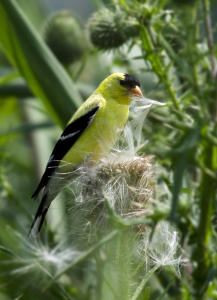Spring is just the beginning of the nesting season for our backyard birds. Some birds will produce numerous broods over the entire summer season and some birds will wait until mid-summer to start nesting.
Multiple Broods Extend the Nesting Season
For instance, American Robins can produce 3 or 4 broods from May through August. Each brood can take up to a month from laying the eggs to the fledging of the babies. Eastern Bluebirds also can produce 2–3 broods per season, with each brood taking 5–6 weeks. And Northern Cardinals produce 2–3 broods each season, taking 3-4 weeks from laying the eggs until the babies leave the nest.

Late-Summer Nesters
American Goldfinches are our latest nesters. They don’t even begin to nest until late June or July, sometimes even into August. Unlike many other species of nesting birds, goldfinches do not feed their babies insects—just seeds. By waiting until later in the season, goldfinches can take advantage of wildflowers in full seed production. They also like to use the seed fluff from milkweed and thistle to build their nests. By waiting until later in the season, they are assured of a good source of food and nesting materials. You can provide nesting materials for goldfinches by hanging a Best Nest Builder fiber bundle, available at any of our All Seasons Wild Bird Stores locations.
You Can Assist Late Nesters
Planting some late-blooming flowers, like goldenrod, aster, and sunflowers will help late-nesting birds. Offering water sources can help when the babies leave the nest. They love to splash around in water.

By Guest Contributor MELISSA BLOCK
■

